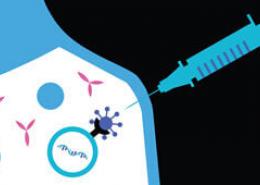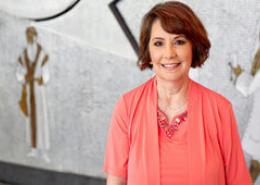
MRNA VS. CONVENTIONAL VACCINES

Working Together to Empower Women

Reducing Health Disparities in Latino Communities

Pfizer Women’s Resource Group

Universal vs. Single Payer Healthcare

A conversation with Dr. Clyde Glenn, President of the Essie B. & William Earl Glenn Foundation for Better Living
In Sunflower County, Mississippi, one of the poorest counties in the nation, our partners at Glenn Family Foundation (GFF) are working to improve health and life outcomes by addressing the social determinants of health impacting this community.
As defined by the Centers for Disease Control and Prevention, social determinants of health are conditions in the places where people live, learn, work, and play that affect a wide range of health and quality-of life-risks and outcomes.
Through its Social Determinants of Health grants portfolio, The Pfizer Foundation seeks to advance health equity and reduce disparities for Black and African American communities in the U.S. We are partnering with community-based partners to reach underserved and underrepresented people and to help ensure healthcare access. As part of the inaugural group of awardees, GFF received $250,000 to launch its Integrated Health Empowerment Awareness and Literacy (I-HEAL) pilot program.
Recently, Darren Back, Executive Director of The Pfizer Foundation connected with Dr. Clyde Glenn, president of GFF to discuss I-HEAL, which aims to improve health literacy, increase health-seeking behavior among participants, and decrease the number of children facing food insecurity.
Darren Back (DR): The Glenn Family Foundation works to improve the lives and health outcomes of communities in the Mississippi Delta. Could you tell us about Sunflower, Mississippi and what life is like there? Which community do you serve and what are some of the health challenges they face?
Dr. Clyde Glenn (CG): Sunflower County, Mississippi has a population of just over 27,000 people, and while diverse, some groups are on parallel economic, social, legal, and political tracks and others much less so.
The Black families in Sunflower County, for example, make up 75 percent of the county’s population and are descendants of people who opened life on the agricultural ladder, mostly as small farmers, tenants, and sharecroppers. The median household income is lower than the state average – around $30,000 annually – and the county has a higher-than-average poverty rate estimated at 33 percent in 2020.
Poor intergenerational educational outcomes, high-risk physical and mental health status, income insecurity, and safe housing drive childhood and adult adversity in Sunflower County. A recent GFF survey found that the most common adverse childhood experiences included living in a family with divorced or separated parents (47 percent), experiencing emotional neglect in childhood (38 percent), and living with a family member with mental health challenges (37 percent).
Access to basic health services is also a challenge. In 2020 there were nearly 3,000 patients for each primary care physician in Sunflower County, compared to 1,900 or 1,050 in Massachusetts and Washington, DC respectively.[1] Sunflower County leads Mississippi as the number one county with the highest rate of deaths due to diabetes.
DB: The I-HEAL pilot program aims to improve health literacy, change behaviors and tackle food insecurity in Sunflower County. Could you tell us more about this program and how you hope it will advance health equity?
CG: Through five modules, I-HEAL offers teachers a set of tools to strengthen students’ capacity and capabilities. By helping build a growth mindset and future orientation, as well as educate around key health issues, including cognitive and emotional health, nutrition, exercise, oral healthcare, diabetes, heart disease and asthma, the modules seek to mitigate and prevent chronic diseases.
I-HEAL encourages new health knowledge, informed health practices, and offers families in this community an opportunity to reset their future health and educational trajectories through a parental toolkit and community engagement.
DB: This program is part of a group of grants focused on addressing social determinants of health to improve health outcomes. How does GFF think about social determinants of health and why do you believe this approach is most effective to change behaviors?
CG: The social determinants of health are the conditions and environments in which people are born, worship, live, learn, work and play. These environments, which can lead to dire individual circumstances, also affect family and community outcomes.
The Glenn Family Foundation is grounded in the belief that a person’s circumstances should not determine their destinies. Our approach is designed to harness the best scientific evidence of human development, collaborate with teachers and strengthen their knowledge and capacity to engage students, and develop tools for parents and their families so they can set goals with a big payoff for healthy future trajectories, including educational and financial well-being.
Children and families that fall behind at the start of life have a difficult time catching up. The cognitive and physical gaps present at the start of life persist unless early exposure to good health and good health practices is normalized. Our integrated I-HEAL approach aims to do just that, recognizing schools and homes as places of strength and growth.
DB: The I-HEAL pilot program uses a variety of approaches to engage the community, ranging from health literature and digital messages to community activities. Could you share some insight into how the program approaches are being developed and what previous learnings are being applied to shape your work moving forward?
CG: The I-HEAL initiative seeks to reset schools and families as strength-based environments, in which healthy learning takes place and healthy progressive goals are set and achieved. The environments we seek to build and sustain could have intergenerational effects and thus build healthier learning communities, in which all members of society treat themselves and are treated by anchor institutions with unconditional positive regard and high expectations.
The integrated economic and historical framework we employ is valuable because context matters. We build on insights from rural populations with large shares of Blacks and have a theory of change that is consonant with neuroscience, human development, and economic history to help clarify the trends that we can both erase and harness.
DB: Food insecurity is a challenge for the community you plan to serve in Sunflower County. Why is this an important focus of the program and how do you believe it will help improve health outcomes?
CG: Economic insecurity means that families cannot afford to purchase healthy foods and/or that families lack the knowledge and time needed to prepare nutritious meals day in and out. The I-HEAL curriculum features healthy nutrition along with oral care and diabetes to show teachers, students, and family members the linkages between what gets consumed, its nutritional value and its harm to one’s physical and cognitive capacities over the life course. Awareness can lead to goal setting and to prioritize eating reasonable portions of healthy foods. Food scarcity can lead to ill-advised consumption of unhealthy foods. It is, therefore, crucial to give children and their families, and teachers sound nutritional knowledge and ideas about healthy eating and its consequences.
DB: How do you believe health interventions focused on young children and youth can help impact health outcomes as they move into adulthood, and how can programs like I-HEAL ensure more lasting impact?
CG: Youth interventions alone are insufficient. It is nonetheless true that once children’s health orientations, knowledge and practices are put into motion, they will likely positively influence their parents. The fragility of our nation’s inequitable economic and health fabric does not support leaving that to chance. Our approach is an integrated multidisciplinary, tightly analytical, and multi-year paradigm. The creation of the I-HEAL parental toolkit is intended to put students and their guardians on parallel tracks in terms of health knowledge, healthy goal-setting, and healthy future orientations. Home reinforcement and supplemental learning will bolster students’ in-class engagement and achievement and restore confidence in schools and teachers’ commitment to students and to schools and families as strengths-based environments, working in tandem.
DB: As you prepare to launch I-HEAL in the Sunflower County community, what is your vision for its success? What do you hope to learn from the pilot and what impact could these insights have on this program and others?
CG: We envision greater teacher enthusiasm and mastery of health knowledge and greater student achievement in numeracy, reading, and health education. We envision more attentive and well-informed and engaged parents. In years two and three of this work, we hope to see improvements in blood pressure, BMI, heart rate, and oral care of teachers, students, and parents. We also expect the future orientation and growth mindsets of all three populations to strengthen.
As for learning on the part of GFF, our work will offer insights about how to leverage and inform teacher engagement with parents and the pivotal role of in-school and in-family goal-setting. After our I-HEAL engagement with schools and parents has been fully Beta tested in several sites and as student and parent health data—pre, during, and post-intervention—starts to evolve, thoughtful analysis of how to scale I-HEAL will open classrooms, schools, and living- and dining rooms across America and beyond, to greater depth and volume in mitigating and preventing chronic disease.
For more information on these programs visit Glenn Family Foundation.
*The Pfizer Foundation is a charitable organization established by Pfizer Inc. It is a separate legal entity from Pfizer Inc. with distinct legal restrictions.
[1] County Health Rankings, March 2020, Robert Wood Johnson and the University of Wisconsin Population Health Institute
Source: Read Full Article